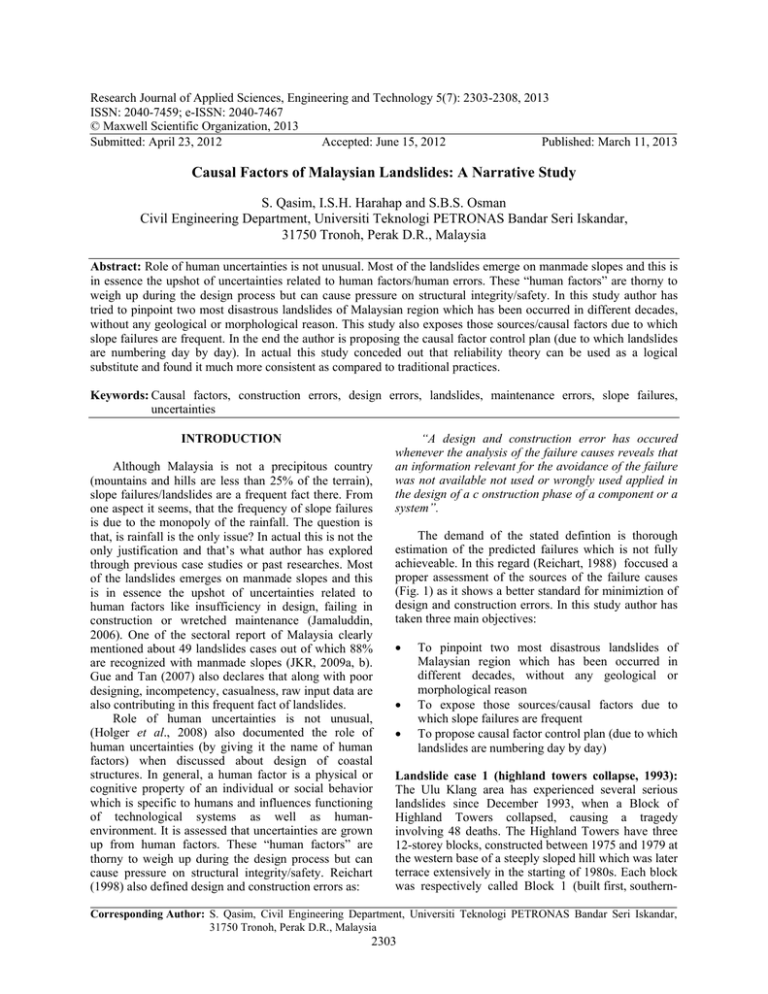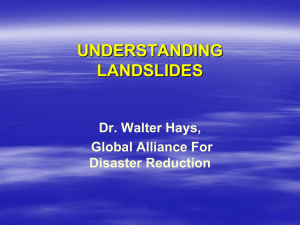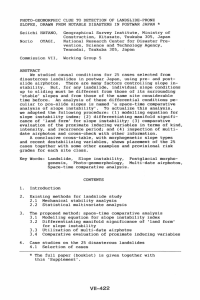Research Journal of Applied Sciences, Engineering and Technology 5(7): 2303-2308,... ISSN: 2040-7459; e-ISSN: 2040-7467
advertisement

Research Journal of Applied Sciences, Engineering and Technology 5(7): 2303-2308, 2013 ISSN: 2040-7459; e-ISSN: 2040-7467 © Maxwell Scientific Organization, 2013 Submitted: April 23, 2012 Accepted: June 15, 2012 Published: March 11, 2013 Causal Factors of Malaysian Landslides: A Narrative Study S. Qasim, I.S.H. Harahap and S.B.S. Osman Civil Engineering Department, Universiti Teknologi PETRONAS Bandar Seri Iskandar, 31750 Tronoh, Perak D.R., Malaysia Abstract: Role of human uncertainties is not unusual. Most of the landslides emerge on manmade slopes and this is in essence the upshot of uncertainties related to human factors/human errors. These “human factors” are thorny to weigh up during the design process but can cause pressure on structural integrity/safety. In this study author has tried to pinpoint two most disastrous landslides of Malaysian region which has been occurred in different decades, without any geological or morphological reason. This study also exposes those sources/causal factors due to which slope failures are frequent. In the end the author is proposing the causal factor control plan (due to which landslides are numbering day by day). In actual this study conceded out that reliability theory can be used as a logical substitute and found it much more consistent as compared to traditional practices. Keywords: Causal factors, construction errors, design errors, landslides, maintenance errors, slope failures, uncertainties INTRODUCTION Although Malaysia is not a precipitous country (mountains and hills are less than 25% of the terrain), slope failures/landslides are a frequent fact there. From one aspect it seems, that the frequency of slope failures is due to the monopoly of the rainfall. The question is that, is rainfall is the only issue? In actual this is not the only justification and that’s what author has explored through previous case studies or past researches. Most of the landslides emerges on manmade slopes and this is in essence the upshot of uncertainties related to human factors like insufficiency in design, failing in construction or wretched maintenance (Jamaluddin, 2006). One of the sectoral report of Malaysia clearly mentioned about 49 landslides cases out of which 88% are recognized with manmade slopes (JKR, 2009a, b). Gue and Tan (2007) also declares that along with poor designing, incompetency, casualness, raw input data are also contributing in this frequent fact of landslides. Role of human uncertainties is not unusual, (Holger et al., 2008) also documented the role of human uncertainties (by giving it the name of human factors) when discussed about design of coastal structures. In general, a human factor is a physical or cognitive property of an individual or social behavior which is specific to humans and influences functioning of technological systems as well as humanenvironment. It is assessed that uncertainties are grown up from human factors. These “human factors” are thorny to weigh up during the design process but can cause pressure on structural integrity/safety. Reichart (1998) also defined design and construction errors as: “A design and construction error has occured whenever the analysis of the failure causes reveals that an information relevant for the avoidance of the failure was not available not used or wrongly used applied in the design of a c onstruction phase of a component or a system”. The demand of the stated defintion is thorough estimation of the predicted failures which is not fully achieveable. In this regard (Reichart, 1988) foccused a proper assessment of the sources of the failure causes (Fig. 1) as it shows a better standard for minimiztion of design and construction errors. In this study author has taken three main objectives: To pinpoint two most disastrous landslides of Malaysian region which has been occurred in different decades, without any geological or morphological reason To expose those sources/causal factors due to which slope failures are frequent To propose causal factor control plan (due to which landslides are numbering day by day) Landslide case 1 (highland towers collapse, 1993): The Ulu Klang area has experienced several serious landslides since December 1993, when a Block of Highland Towers collapsed, causing a tragedy involving 48 deaths. The Highland Towers have three 12-storey blocks, constructed between 1975 and 1979 at the western base of a steeply sloped hill which was later terrace extensively in the starting of 1980s. Each block was respectively called Block 1 (built first, southern- Corresponding Author: S. Qasim, Civil Engineering Department, Universiti Teknologi PETRONAS Bandar Seri Iskandar, 31750 Tronoh, Perak D.R., Malaysia 2303 Res. J. Appl. Sci. Eng. Technol., 5(7): 2303-2308, 2013 Fig. 1: Design or construction error (Reichart, 1988) most), Block 2 (built second, north-northwest of block 1, slightly elevated than the other two, closer in to the hill) and Block 3 (built last, northwest of block 1, west of block 2). The total length of landslide was 120 m and width of rupture surface was about 90 m involving round about 40,000 m3 of debris. Regarding this landslide the most authentic report has been produced by Ampang Jaya Town Council that (MPAJ, 1994) Highland Tower collapse main cause is inadequate drainage. From another aspect, design deficiencies are also found. The report has (MPAJ, 1994) following concluded factors responsible for this landslide (Jaapar, 2006): Buckling and shearing of rail piles foundation persuade by soil movement Surface runoff due to improper drainage facility Cut and fill slopes, rubble walls around Block I showed inadequate design (carrying safety factor <1) and poorly administered construction Slope gradient is suspected to be very steep No maintained drainage system along with leakage from pipe culvert carrying diverted flow of East stream From the computational analysis done by Prof Simon, (Nguee, 2006) revealed the facts that high wall has very low safety factor and the designed wall would fail at 5 m very simply even not including water pressure. The calculated safety factor of all those walls which were at the back of Block 1 is 1.52, even without allowing water forces at the back of the walls. It is also observed under the same study that wall composed of different size of stones with haphazard plaster carrying no drainage blanket over it. A disquieting point was that it had no base, directly rests on ground. Landslide case 2 (Bukit Antarabangsa, 2008): On 6th December 2008, a landslide was occurred at Taman Bukit Mewah, Bukit Antarabangsa, Hulu Kelang, Selangor. The landslide took place around 3.30 a.m., having 109 m in width at the crest, 120 m in length, 15 m in depth and the angle of the scarp of the crown ranges from 45° to 50°. It was observed that 101,500 m3 of earth had translated and the maximum run out distance of the failure debris was 210 m from the toe of the slope. MPAJ reported about Bukit Antarabangsa (2008), (quite latest landslide) that leaking pipelines near Jalan Wangsa 11 very close to the landslide area are responsible to build up water pressure in the soil pores. It is already pinpointed by the authorities that no signs of earth motion are shown in the seismic records so possibilities of triggering this landslide due to earthquake forces are totally zero. Another aspect which is tried to pinpoint is that Bukit Antarabangsa is the outcome of pipe burst or calling it a rare event. In other words it’s claiming that due to bursting of water pipe this landslide occurs. As already discussed by Harahap and Aini (2010) that this accident has been taken place after 20 years of project development and its thought to be the result of pipe burst on hill top due to which landslide occurs. It’s obvious that rare event theory is governing here as bursting of pipe is not a usual event plus it happens in peak monsoon season. All the facts and theories exist but this is only the superficial observation. Why bursting of pipe happens? Question is that, is it an accidental happening? Around the same area in 1999 an incident of landslide has been occurred but due to no fatalities it seems to be less debatable. If specifically referring the two case histories pinpointed by Bukit Antarabangsa (1999, 2008), one common feature is the poor or inadequate drainage. 2304 Res. J. Appl. Sci. Eng. Technol., 5(7): 2303-2308, 2013 Table 1: Chronological slope failure events (JKR, 2009a, b) Dates Landslide/slope failure events 14.12.1984 Slope failure at block 13 22.08.1985 Slope failure at the end of Jalan Wangsa 9 at block 12 14.10.1985 Signs of distress were appeared along Jalan Wangsa 9 with prominent cracks expanding approximately from lots 6280 to 6287 from block 13 08.11.1985 Block 13 and block 16 collapsed 06.12.2008 Landslide occurred at same location of block 13 and block 16 which toppled in 1985 Clogged drains or even no sign of berms drain construction in Bukit Antarabangsa (1999). Landslides disasters for this particular area of Bukit Antarabangsa is not surprising as history shows (Table 1) that this area is very prone to slope failures. Sequential events relating to the site are as under: The 6th December 2008 landslide was heralded by a sequence of low rainfall events, which was having much less potential to trigger landslide. From the rainfall study, it is questionable that rainfall incident is the main triggering factor for this particular landslide of 6th December 2008. Other highly contributing factors such as the conditions of drainage, sub-soil, geology, groundwater, underground piping etc., ought to be investigated to find out the tangible origin of the landslide. It is confirmed through (Fatt and Fang, 2009), that Bukit Antarabangsa area had faced very high level precipitation in November 2008 with 23 rain days, which might have potential to cause landslides. However, no severe landslide happening was reported during this soggy period. Correspondingly, (Samah, 2007) who conducted a case study of hillside problems in Bukit Antarabangsa, Selangor found that professionals involve in hillside developments are not alert in following the regulations and fail to take up good planning and design practice for hillside development. Design error is recognized as the most important risk for the success of a project that leads to cost overruns and delay (Andi and Minato, 2003; Kaliba et al., 2009; Sweis et al., 2008). Gue and Tan (2006) who investigate the hillside development projects in Malaysia also found that 60% of 49 landslide cases are due to design errors caused by inappropriate design check and 20% sources are by a combination of design and construction errors. Short of communication and poor coordination among project participants during the early stage also contribute to the many failure of hillside development. For example, (Rasip, 2006) found that there is a lack of contact and cooperation between responsible technical departments in caring the development of hillsides. Error producing conditions in Malaysian landslides: During the life cycle, of engineering systems from scheduling, designing, construction, installation, fabrication till maintenance, humans have to work sometimes as a planner, designer or a supervisor. Errors spawn through their actions are mentioned as design errors, construction errors or maintenance errors. In this way human uncertainties come into existence or simply speaking these are the results of human mistakes/ errors. On many occasions humans were the basis of devastating failures. Bea (2006) organized uncertainties into four categories with respect to major failures/accidents as: Natural variability Modeling Human and organizational Knowledge based Morgenstern (1995) pointed out the catastrophic failure of Kwun Lung Lau landslide in Hong Kong. It is the input of human uncertainty. It is also reported by Ellingwood (1987) that mostly accidents or structural failures are not due to variation in the loads or resistances but in actual it’s the outcome of the human errors. Design errors like abusing of the prescriptive method, construction errors pinpointing over excavation or wrong side excavation and in case of maintenance errors like clogged drainage system. These are the outstanding human errors pragmatic by Malaysian construction industry when rapid boost in slope failures takes place in different regions of Malaysia (Gue and Wong, 2008). The above mentioned scenario reflects the urgent need of Human Reliability Assessment (HRA) to control these diverse situations prevailing in Malaysian construction industry. Human reliability assessment relies on two different types of approaches for evaluation or estimation: one carrying databases and other totally relying on expert’s opinion. The first category consists of those techniques which has already in hand generic error probabilities. These generic probabilities are than manipulate by the evaluator to extrapolate from the generic data to the particular scenario being considered. Manipulation is usually stood on assessor’s judgment of situation governing Performance Shaping Factors (PSFs) or Error Producing Conditions (EPCs). Techniques lie in second category are not so structured, totally relying on personal communication and asking to estimate the probabilities or proportion of the 2305 Res. J. Appl. Sci. Eng. Technol., 5(7): 2303-2308, 2013 Table 2: Design (D) Construction (C) and Maintenance (M) error sources No Behavioral/technical sources No Behavioral/technical source D1 Time constraints C1 Improper sequencing D2 Avoiding new codes/software’s used in C2 Lacking in supervision designing D3 Poor coordination among the personnel C3 Poor working environment or coordination D4 Unhealthy working environment C4 Personal reasons D5 Individuals attitude C5 D6 1v:1h gradient not considering slope height and geology Inaccurate soil parameters used No previous records Deficient or unclear standards/codes Follow up of unsuitable procedures not taking its effects C6 Over excavation/improper method of excavation Inadequate temporary support C7 C8 C9 C10 Excessive construction loads Material deficiencies Application of new technology Aged/poorly calibrated equipments D7 D8 D9 D10 situation related EPCs. The logic of assessing its proportion is to check whether how much the impact is creating and in which way it can be minimized or neutralized. Like some of the EPCs demands corrections in the prevailing codes and practices and some requires training sessions and workshops and scrutinization. The EPCs which are responsible for Malaysian slope failures in three distinct phases are given in Table 2. The list of EPCs has been prepared by following the second human reliability assessment approach of expert’s opinion. Expert’s opinion approach requires individuals having the knowledge and experience of the targeted tasks. A panel of six is at least required for estimation (Grozdanovic, 2005). The research follows Aggregated Individual Method and Consensus Group Method to work on the expert’s opinion strategy. These methods are preferable as the opinions obtained through them are unbiased. Secondly author considers its less time consuming. Methods like Delphi and Nominal Groups entail more than one round and not let the expert to answer independently. Causal factors control plan: In order to overcome the consequences preventive measures has to take first in connection with landslides. It is not logical to take the action after some reaction, plans has to taken before the consequences not to cover the effects of the consequences. Like when talking about Slope failures, ample amount of compensatory and non compensatory losses has been occurred. The statistics of landslide cases reported by Gue and Tan (2007) clearly indicates the domination of design flaws. Among 49 cases of slope failures, 29 cases are referring to design deficiencies. Deficit design cases are not unusual but still no proper move has been taken. Design and construction deficiencies are basically of improper understanding of soil behavior, inaccurate testing of soil properties and poor management of prescriptive method. Like in prescriptive method, gradient of the No M1 M2 Behavioral/technical source Poor communication Financial matters M3 Non awareness of consequences M4 M5 Application of unsuitable maintenance criteria Following outdated strategies M6 Weak decisive power M7 Untrained/unskilled force involved slope is fixed without knowing the geotechnical conditions neither going in any calculation details. Usually 1H:1V means having an angle of 45º. This gradient is not giving sufficient factor of safety in connection with high risk and damages. In actual these are uncertainties/risks related to the parameters involved in designing, which will not be overcome by conventional approaches. Spatial Variability in soil cannot be easily quantified as its inherent material. To cancel out its negativities thorough testing of soil properties has to be worked out. The role of testing methods is not the only task to cover but the methods and the techniques used to mitigate landslides must be carried out logically. Relying on positivity and assuming only on the basis of single safety factor value that slope is stable is absolutely a wrong assumption. Safety factor approach no doubt is an authentic source but with some extent. Is the slope is 100% safe? Is the chances of failure is 0%? The replies of these questions are only reliability based design approach. This is the suitable approach to counter uncertainties. As development is also in continuation without noting the land excuses, following points also has to be furnished: 2306 Identification of landslide prone areas has to be detected through mapping. Modifications and alterations in the building codes with respect to design and construction practices, maintenance and inspections criteria must be incorporated to catch the future coming expenses. Rules and regulations will have to be implemented by the concerned authorities and immediate action in case of violation will be followed. International support and cooperation, in terms of change of technology and reciprocal of expertise as vice versa. Probabilistic models like PFR model (Mehrnoosh et al., 2009) must be developed to determine the Res. J. Appl. Sci. Eng. Technol., 5(7): 2303-2308, 2013 landslide vulnerability and the factors contributing in it. This model is basically assuming that future landslides have correlation with past landslides. Approach having frequency ratio tries to observe the relation between the factors attributed and the landslides occurrences. Determination of frequency ratio values for ranges of all factors attributed (slope gradient, litho logy, distance from drainage, soil etc.) dividing the landslide occurrence ratio by ratio of total (specific) area. Landslide Susceptibility Index (LSI) is the second calculated value after frequency ratio value. Confirmation and effect analysis is off course the second target of any of the model, evidence has to be provided for the validation of the results and changes will observe in case of change input variables. As uncertainties loop up with different variables must be different. Provision or flexibility in the model is also main requirement to run any of the models. SUMMARY AND CONCLUSION In spite of years of accrued experience, the aptitude of the geotechnical profession to formulate reliable predictions for slope failures/stability remains deprived. This is principally due to the copious sources of uncertainty that take over performance outcrops in geotechnical engineering. Intrinsic natural unpredictability of soil properties, lack of data, restrictions of models and above all human uncertainties are some of the challenges that geotechnical engineers has to bear in routine. In this regard probabilistic techniques are most suitable option to quantify and incorporate uncertainty into slope analysis and design as compared to the traditional loom of safety factor. In actual this study conceded out that reliability theory can be used as a logical substitute and found it much more consistent. REFERENCES Andi and T. Minato, 2003. Design documents quality in the Japanese construction industry, factors influencing and impacts on construction process. Int. J. Proj. Manage., 21(7): 537-546. Bea, R., 2006. Reliability and human factors in geotechnical engineering. J. Geotech. Geoenviron. Eng., 132(5): 631-643. Ellingwood, B., 1987. Design and construction error effects on structural reliability. J. Struct. Eng., 113(2): 409-422. Fatt, C.S. and Y.S. Fang, 2009. Study of the Rainfall Characteristics of Bukit Antarabangsa Area In Relation To the Landslide Incident on 6th December 2008. 11th Annual IEM Water Resources Colloquium 2009. Grozdanovic, M., 2005. Usage of human reliability quantification methods. Int. J. Occup. Saf. Ergo., 11(2): 153-159. Gue, S.S. and Y.C. Tan, 2006. Landslides: Cases Histories, Lessen Learned and Mitigation Measures. Paper Presented at the Landslide, Sinkhole, Structure Failure: Myth or Science? Ipoh, Malaysia. Gue, S.S. and Y.C. Tan, 2007. Landslides: Abuses of the prescriptive method. International Conference on Slope 2006 Kuala Lumpur, Malaysia. Gue, S.S. and S.Y. Wong, 2008. How to Improve Slope Management and Slope Engineering Practices in Malaysia. Retrieved from: www.gnpgeo.com.my. Harahap, I.S.H. and F. Aini, 2010. On Aspects of Geotechnical Risk Assessment for Hillside Development. International Conference on Sustainable Building and Infrastructure (ICSBI2010) Kuala Lumpur, Malaysia. Holger, S., K. Andreas, F. Peter and P. Karsten, 2008. Uncertainties I’m Coastal Structure Design by Expert Judgement. Chinese-German Joint Symposium on Hydraulic and Ocean Engineering, August 24-30, 2008, Darmstadt. Jaapar, A.R.B., 2006. A Framework of a National Slope Safety System for Malaysia. University of Hong Kong, Malaysia. Jamaluddin, T.A., 2006. Human factors and slope failures in Malaysia. Bull. Geol. Soc. Malaysia, 52: 75-84. JKR, 2009a. Final Investigation Report Nvestigation of Slope Failure at Taman Bukit Mewah. Bukit Antarabangsa Hulu Klang Salengor. Cawangan Kejuruteraan Cerun, Jabatan Kerja Raya Malaysia. 1. JKR, 2009b. National Slope Master Plan. Sectoral Report Research and Development, Jabatan Kerja Raya Malaysia. Kaliba, C., M. Muya and M. Kanyuka, 2009. Cost escalation and schedule delays in road construction projects in Zambia. Int. J. Proj. Manage., 27(5): 522-531. Mehrnoosh, J., 2009. Landslide susceptibility evaluation and factor effect analysis using probabilistic-frequency ratio model. Eur. J. Sci. Res., 33(4): 654-668. Morgenstern, N.R., 1995. Managing risk in geotechnical engineering. 10th Pan American Conference on Soil Mechanics and Foundation Engineering. 2307 Res. J. Appl. Sci. Eng. Technol., 5(7): 2303-2308, 2013 MPAJ, 1994. Report of the Technical Committee of Investigations on the Collapse of Block 1 and the Stability of Block 2 and 3 Highland Towers Condominium Hulu Klang Selangor Darul Ehsan. Nguee, C.S., 2006. Case studies on forensic structural engineering. M.Sc. Thesis, Civil Engineering, Universiti Teknologi, Malaysia. Rasip, M.K., 2006. Development Issues in the Highlands and Mountainous Areas (Case Study: Ampang Jaya Municipal Council) Universiti Teknologi Malaysia, Johor Bahru. Reichart, G., 1988. How to reduce Design and Construction errors. Nucl. Eng. Desig., 110(2): 251-254. Samah, F.A., 2007. Landslide in Hillside Development in the Hulu Kelang, Klang Valley. Presented at the Post-Graduate Seminar Universiti Teknologi Malaysia. Sweis, G., R. Sweis, A.A. Hammadc and A. Shboul, 2008. Delays in construction projects: The case of Jordan. Int. J. Proj. Manage., 26(6): 665-674. 2308



